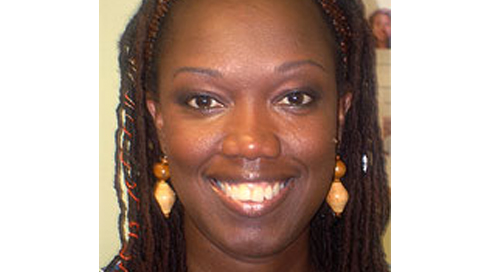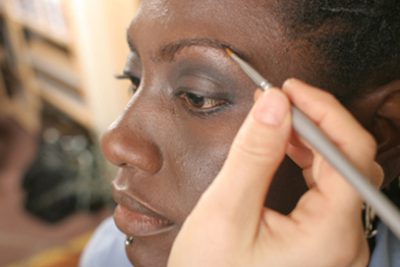This is definitely going to be a multi-part post, because there is a lot I can say about this subject. I’ve been applying makeup to women of color, especially African American women, for 12 years. My first kiosk was in Baltimore’s Inner Harbor, and I met many professional women in the area, as it’s very close to the business district where there are many offices, law services, and courthouses.
Along the way, I learned what most women with med-dark skin tones have learned (lighter complected women, although classified by our ‘one-drop’ theory as African American, do not typically experience this particular issue), which is that their face is not only one shade.

Since this is a primary issue when choosing a makeup foundation shade, I’ll focus on that for this first discussion.
Typically, what darker skin will display, are blue to brown tones around the chin and the borders of the face, as well as near the nose. These are deeper, richer tones. Then along the nose, across the tops of the cheeks (under the eyes), and in the middle of the forehead, will be lighter, more pearlescent tones, in shades of Golden, Copper, and Sunset Red.
The problem is in how to cater to both of these skin tones. Most makeup foundations only cater to one. So when a woman buys a shade that matches her beautiful copper tones, then the darker parts of her face look lighter, (ashy) and washed out. If she buys something that matches the darker tones of her face, then she looks ‘dead’, and the lively, pearlescent copper and gold tones don’t show through.
So, what is the solution? Applying two or more shades in different places on the face? Mixing complicated blends of various brands and foundations? This is what many African American women suffer through, and in the process, end up with some pretty awful formulations that can cause breakouts and irritation.
The solution is in the formula itself. I’m not a trained chemist. So no one taught me ‘how’ to make makeup. When I first started crafting makeup, I thought I was crazy. That’s always a fun moment. I was convinced that I didn’t know what I was doing. But I come from a family of crafters and do-it-yourselfers, and it’s just how we roll!
So, after attending a makeup show, and purchasing a decent brand of mineral makeup that was completely priced out of the Baltimore market, I decided that, based on reading the ingredients list in the jar of foundation in my hand, that I would try my hand at making some. So, after experimenting on myself and finally coming up with something that covered my then-terrible acne, and that perfectly matched my olive skin (that was a first!!), I dragged my little bags of pigments that I had so carefully searched for online, and a coffee grinder (it took forever to figure out what to use to blend them, but that’s what I settled on) to my kiosk, and started experimenting on my customers.
I still remember my ‘ah-hah’ moment when I had made a decent chocolatey-red-brown shade for a woman who patiently sat while I blended away. Nothing looked quite right. She had alot of red in her skin, but no matter what I put in the formula, nothing matched it. Then my eye was drawn to a beautiful powder that I often used as a blush, or lip pigment, very shiny, and not something I was ever taught should be used on the face, due to its pearlescence. I blended a little right onto her cheeks and it looked beautiful. It was the magic trick. I knew that I was on to something.
That was a magical moment, and it has transformed the faces of many a women that purchases not only from Monave, but from all of the crafters over the years that have learned from my classes, and kits, and from the people who launched makeup lines based on the on-line recipes sprouting up over the years on crafters sites, not even knowing where that information came from.
From that point on, I knew that to truly address the varying shades of beautiful on darker skin, that I would combine matte pigments to create the chocolatel undertones, and pearlescent pigments to bring out the copper, gold and red tones.
I love applying our loose mineral foundation to women of color who come to the Monave Makeup studio. We know we have a match when they can’t see it. It’s actually disconcerting to some women because they believe that if they can’t see it, it’s not working.
So, the old adage that mineral makeup can’t work for Black Women is not true. Those formulations are simply not great. They don’t address the multi-toned issue, and they often use very reflective pigments for parts of the face that should be more matte (such as titanium dioxide). So, how can a women of color find a good formula for her skin tone?
My first suggestion is to stick to handmade, boutique quality mineral makeup. Those beautiful, shiny pigments are pricey, and larger brands are most interested in profit, and won’t invest in these pigments for a foundation.
My second suggestion is to search for information on someone’s site on at their store, that specifically focuses on women of color. If they are addressing the issues, there’s a higher likelihood that they have experience with med-dark skin tones. Unfortunately, due to the still racist society that we live in, the cosmetics industry does not educate cosmetologists properly on how to match products for women of color.
This is shameful, but true, so there are many cosmetics companies that have one or two shades for darker skinned women. This is an impossible task, to fit all of the Rainbow shades of Beauty represented by Black Women into 2 shades, so you can assume that merchant cares enough to offer something, but that she may not have the training or experience to know what to stock.
We’ll address some more issues on matching skin tones for women of color, but I hope that this article touches on the one that I find most prominent and difficult for women searching for their Holy Grail color.
If you are interested in trying our foundation shades, please visit our loose mineral foundation page to learn about the various shades we offer, and then click on our samples page to order a sample set in your range or color grouping. We’re also available to consult with you by email or phone for color selection or application questions.
Teporah


